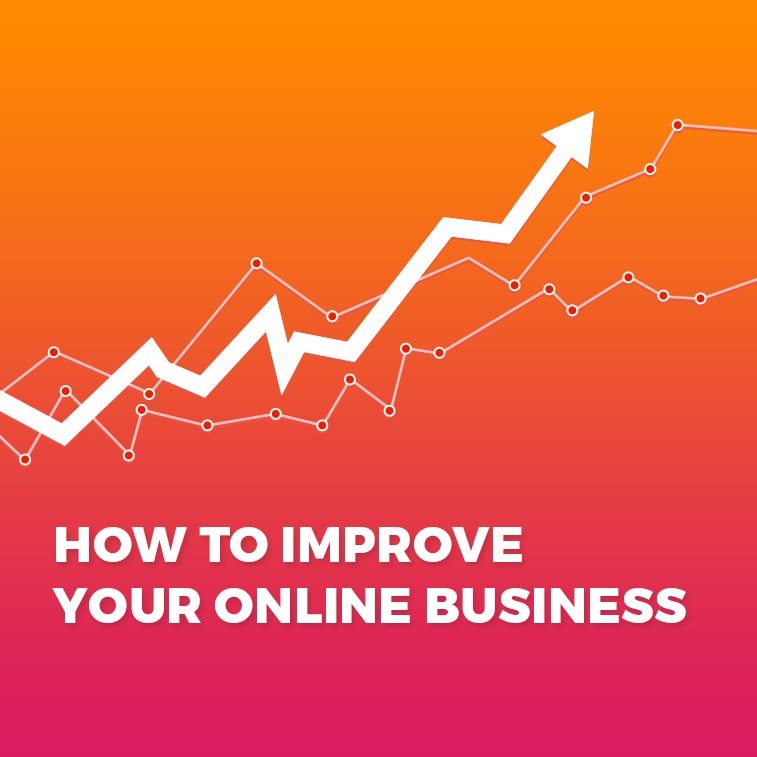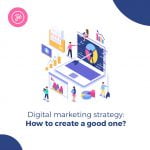If you have set up your business, you probably already have a business website. In case you are in e-commerce, you surely have an online store as well. However, your results are still dissatisfactory and you wish to improve your online presence and to take your business to a higher level. What should you do?
Actually, there are plenty of options in store – from building a more quality website, investing in social media marketing, starting a paid Google (or some other browser) campaign, promoting in business directories, establishing a business network, investing in marketing content, writing blogs, promoting PR texts, and much more.
If you are puzzled as to where to begin, you are in the right place. Here, we are going to go through each of the aforementioned possibilities to help you get out of the woods of digital promotion.
Are You Satisfied With Your Online Presence?
Back in 2015, medium.com surveyed 3400 small business across US, UK, Australia, and Canada, finding that only 30% have a ‘modern’ website (meaning it is younger than 5 years), 60% have websites which are not mobile-friendly, and an astonishing 10% had no website at all. Interestingly, many of these website-less businesses actually had a Facebook page where they did online promotions.
According to G2 Crowd, around 80% of US small-business owners used Facebook, and 51% opted for Twitter as their marketing platforms. Facebook proved a double-edged sword, as 38% reported they benefited from marketing on Facebook, whereas 29% identified it as their least successful marketing venture. Almost a quarter of the questioned stated that additional improvements and investments in social media marketing is their agenda for the near future.
Facebook took the lead in Clutch’s 2018 survey on 350 small businesses in the US as well, as 12% of the examined businesses used only this platform to promote their work online. 70% of the surveyed businesses used social media, with Facebook topping the list with 86%, almost double comparing to the runner-up Instagram, which is used by 48% of small businesses. YouTube, Twitter, and LinkedIn followed, with Snapchat coming last. In addition, the survey showed that women are more inclined to use social media for business than men (74% vs 66%) and that the majority of millennial businesses (79%) see the advantages of going online, as compared to business people over 35 (65%).
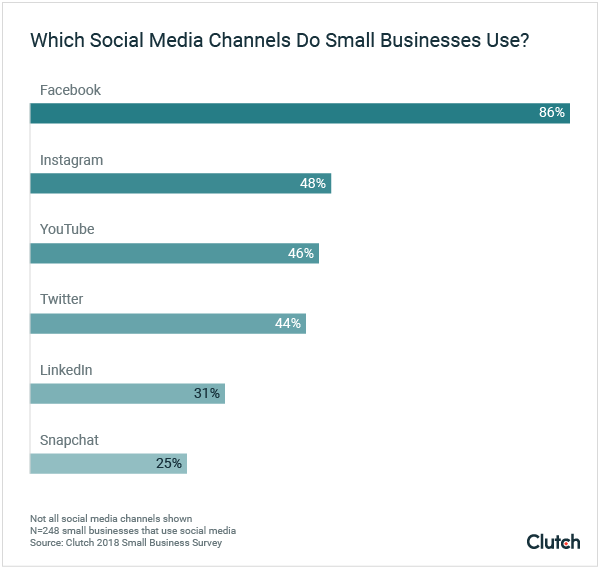
In 2018, UK Office for National Statistics reported that 45% of businesses in the UK have a website, whereas the percentage for Australia, according to Telstra Small Business Intelligence Report, was a bit higher (50%).
A 2019 e-commerce research revealed that 46% of US small businesses do not have a website. On the other hand, smallbiztrends.com called on The Manifest research which stated that out of 529 surveyed small businesses, ¾ use Facebook, Instagram, or Twitter, and that 57% invest in email marketing.
If you are still doubtful as to why your business should go online, take a look at these data. A recent survey by Google suggested that 50% of customers who conducted a local search via their mobiles went to the researched store within a day, whereas 34% of desktop searches resulted in the same. Furthermore, almost a fifth of local mobile searches led to a customer purchase in less than a day. The aforementioned Telstra research showed that 62% of customers dismiss services from businesses if they are unable to search for additional information online. Another statistic report on small and medium businesses in the US discovered that web design is one of the top reasons why clients mistrust, or even entirely reject a certain business.
Avocadosocial.com states that 80% of Instagram users in the UK follow a business or a brand via this platform. What’s more, according to multiple research, Americans largely rely on social media for their retail discoveries, with 78% of them finding a product on Facebook and a slightly lower percentage (59) on Instagram and Pinterest. And if all these facts have not made you a believer yet, a 2019 survey found that an impressive 96% of Americans opt for shopping online.
So, why is it still that the significance of social media presence is unrecognized by some business owners? Numerous research suggested three main reasons as to why – businesses consider themselves too small to promote their services online, they regard social media marketing a burdensome chore, or they find services of marketing professionals too costly.
However, do social networks do the trick for your business? Well, not really. Wondering why? It is because people expect you to have a website, they more easily gain trust in your brand if you have a web presentation or an e-store, and are therefore more willing to buy your product or order your service. Active social media presence is only a part of your online promotion and building brand reputation.
What else is there to help you boost your sale, strengthen your brand and digital promotion?
Whether you are an entrepreneur, founder of a startup company, owner of a small or medium business, or a CEO of a multinational corporation, the following guidelines are sure to help you improve your online business.
7 Ways towards a successful online business
1. Purpose, intention, and organization of the website content
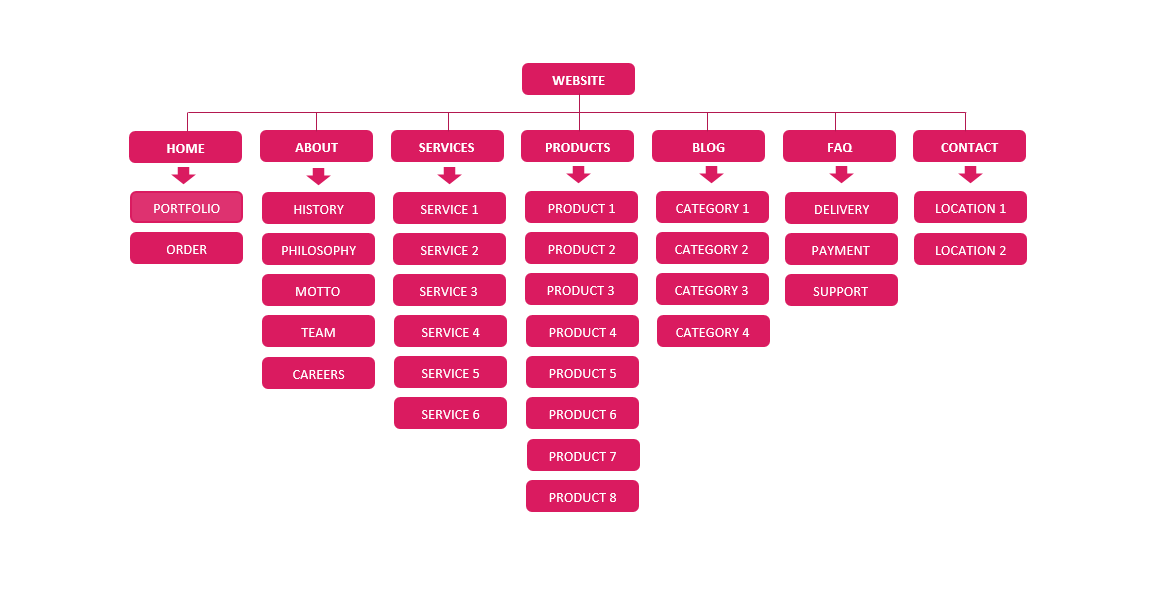
To improve your online business, you need a professionally made website. By professional, we mean functionality, purposefulness, and user-friendliness, for both end-users and website administrators.
Before you start the website building process, think of its purpose. Are you making a portfolio, a web presentation, e-store, online reservation system, a web catalog, media portal, online magazine, or something else?
The next important step is the structural organization of the website, which encompasses the following:
- Main navigation menu – usually those are About Us, Products/Services, Team, Contact, and other pages
- Content categorization – whereby each of the categories can have multiple subcategories leading to individual pages of products/services
- Content functionality and filtering – if needed, they include reservation system, search filters, order forms, shopping cart, contact forms, payment form, implementation of online payment services etc.
- Structural division of an individual page – each web page should consist of an introductory text, detailed description of products/services/work, call to action buttons, links to other pages from the same category or subcategory (most often in the sidebar, but also in header or footer)
- Multimedia content for internal individual pages – photographs, infographics, illustrations, videos etc. especially made for your website
- Blog section – generally understood as a separate categorization depending on topics, tagging the content, internal linking etc.
The choice of a platform for setting up your website lies in whether you decide for service ordering option, or implementing complete e-commerce and online shopping solutions.
For example, you are starting your own blog, so your platform of choice should be WordPress, Squarespace, Wix, Weebly, or something similar. For an online store, the best is to choose a platform designed for e-commerce, such as WooCommerce, Shopift or Magento. You can even do it yourself, but if website technicalities are not your cup of tea, leave it to the professionals.
2. Write content that sells
So, you have decided to start a website, or improve the one you already have. The next crucial step to think of is – content.
Everything you post on your website, business blog, in marketing campaigns, newsletters, or social networks, should be coherent with your business philosophy, and highlight the values you cherish. That makes it easier for your target audience to identify with your brand, and build up trust in you.
You should, however, differentiate between the content for website’s shopping pages, and what you post on your blog.
Website’s landing page has to be informative, showcasing your work, briefly describing the products or services you offer. Links and call to action buttons on the landing page can lead to other, individual webpages that will provide more detailed information.
On websites’ individual pages for services, content should represent your service, straightforwardly indicating the benefits your users will gain. That content should not focus on you or your company, but your customers and advantages they get by using your services or buying your products.
The goal of promotional content is most often to increase conversion rate, whether you want to rise the number of your subscribers or members, shoppers, or boosting your sales and profit.
How to write the content that sells?
If you wish to tackle your website content by yourself, we recommend some of the guidelines by Joana Wiebe, who started the company Copyhackers and coined the term conversion copywriting.
According to her, writing content that sells means a complex process with a certain framework, formula, and placing the user in the center. The entire writing process should be thoughtful, with a specific intention and a long-term aim, checked, tested, and validated. The content should be based on factual data, but presented in a way that creatively evokes audience’ emotions.
Blog, on the other hand, represents original articles which answer the questions of the target audience in an understandable manner, solve their problems, and provide educational, informative, and useful content. Topics should be covered from varied perspectives, thoroughly and with expertize, following the latest trends and practices, including a subtle promotion of your company or services.
3. Invest in Google Ads
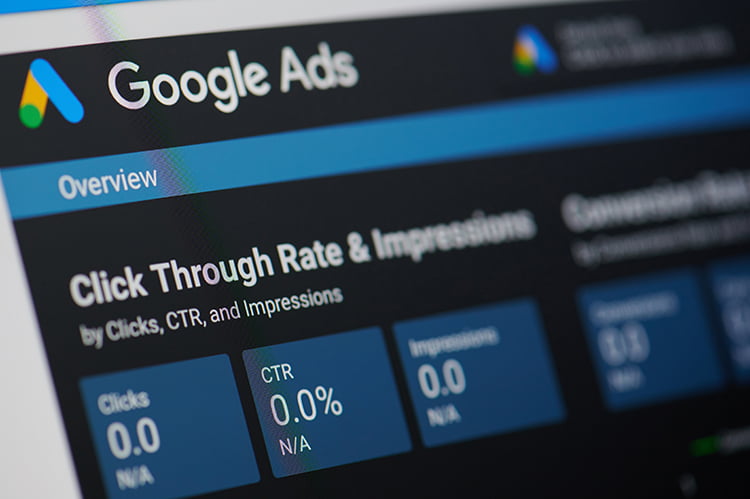
Advertising on Google or other browsers is the right choice for you, if you aim to be on the first search engine results page, and you are willing to invest in it. Google Ads, an updated version of Google AdWords tool, is an efficient solution to shoot your website to the top.
It is recommended to start a digital campaign for a single product or service, such as promoting the latest product in store, a special month-long discount, the least requested service you wish to promote, or anything else.
The first step is to research and choose keywords for which you want to market the campaign, then set the parameters based on location and time of ad publishing, length of the campaign, and so on. Set the budget in advance, and there is also an option of evaluation, where you can get an estimate of the price per click.
This puts you in control over the advertising process, and you will pay only when users click on your ad (pay per click, PPC). The overall price will depend on several factors – your budget, location, industry domain, competitors’ strength, keyword search demand, and many other parameters.
Google Ads offers numerous possibilities for advertising of small and medium businesses, e-stores, hotels, mobile apps, as well as estimating campaign price, and dynamic search ads.
When you decide to start a Google Ads campaign, we recommend that you first:
- Investigate the market
- Check competitors’ ways of advertising
- Carefully choose keywords for which you want to publish your ads
- Set a daily or monthly budget
- Establish a clear conversion goal
With a clear goal, you can zealously follow conversions, check results, and estimate whether your campaign has paid off, i.e. what is the return on investment (ROI). If it proves unsuccessful, you can always try a new campaign next month.
Besides, if you want to test more campaigns simultaneously, Google allows you parallel testing of ads variations, and therefore you can decide for the one that gives the best results.
4. Promote via business directories and address books
Active promotion via business portals, online catalogs, address books and local web directories can take you a step closer to the first place in search results.
Listing your company in business directories will spread the word about your business across the Internet, you will get the chance to leave your contact data, set a map location, provide a description of the route to your company, achieve the possibility of a direct contact, describe your work, vision, mission, business philosophy, leave data on services and products, photos, videos, website links, and mush more, usually all for free.
Do not know where to start? If you are in business on the territories of the US, the UK, or New Zealand, it will be useful to check our lists of business directories in the United States, the United Kingdom, and New Zealand, which can be an excellent starting point to increase your visibility on the Internet, strengthen your brand, and improve online business.
Keep in mind that SEO is a long process and that results do not come over night. Be patient, set long-term goals, and make a strategy. Website optimization pays off in the long run, and brings more lasting results than one-time ad.
5. Invest in social media promotion
Social media presence is today’s imperative for all the companies that wish to position higher on the market, be the topic of discussion, nurture the relationship with their followers and loyal customers, and bring a large number of new clients and users.
Having in mind the large number of social media out there, you must have already heard that you should be where your customers are. Therefore, the most important questions is – who is your target group?
If you have, for example, a fashion brand intended for teenagers and youth, Instagram could be your primary choice. The same goes for an e-store, because Instagram has recently rolled out the feature of shopping directly via their app, which is already largely used. If you have B2B company, and your target audience are managers and decision makers in companies from a certain domain, you should focus on LinkedIn. For a wider target group, Facebook is the best choice.
It is important that when creating business profiles and pages you enter all the necessary information. When you are creating a business page on Facebook, for example, make sure that all fields contain unique content. In About section write your company’s description, tell the story of your company in Our Story, add company logo, website link, service descriptions, photos of products, interior and exterior, and even videos if you have them.
To make your social media profile more complete and more appealing to customers, from the very beginning, encourage your loyal clients to leave reviews on your business’ profiles.
If your goal is to increase your profile visibility or reach, promote your services, highlight the most important products, or offer special discounts, you can advertise on social media. Each of these posts can be promoted for a certain budget, at the same time aiming at audience based on different demographic data and interests.
You can even purposefully create campaigns with more detailed possibilities of setting a goal and audience to which the ad will be shown. In this case, you set the budget yourself.
Of course, keep the communication with your followers on a professional level. That goes for every profile post as well, because you should be careful what image of your business and brand you create, at every moment.
6. PR and guest articles promotion
Writing guest articles which you will publish on blogs or portals related to your business domain, can be a great way to promote your company, product, service, action, novelties, etc. in an original and relevant way.
Online magazines, personal or professional blogs of renowned personalities from your branch and business portals that allow publishing of guest articles on their website can be a good place to promote your content. That way you can raise awareness of your brands’ existence, increase visibility, build a positive reputation, strengthen your domain, and set up a network of relevant and reliable backlinks.
If you want your articles published, have in mind that you should not praise yourself, nor your company, and products. Instead, take time to carefully review each website you wish to publish on, research what they have already written about, familiarize with the writing style, look for guest articles guidelines, reach out and establish a cooperation.
No one forbids you to publish more than one article, and you can even become a guest author on some of the portals, which gives you a chance to regularly publish your articles on websites which will help you reach out to larger number of people from your target group.
7 Build a partnership network
Finding companies, clients, and organization from your branch can help your industry, and establishing a long-term cooperation and relationship based on trust, can significantly contribute to a more positive image, and better online position of your brand.
For example, you are an owner of an online school supplies store, you can create a partnership with a children’s clothing store. Or, if your company is in education and professional training, your partners can be universities and educational institutions related to your branch.
Therefore, a cooperation, and exchange of links and logos, in case they have a website, can be established with long-term clients and companies and organizations from similar industries.
You can also create a Partners section on the home page of your website, where you can present your partnership network, or you can dedicate a separate page to this. It will be an excellent way to show your website visitors that you are among renowned and respected companies in your industry. It will ease gaining trust in your brand, and at the same time, improve your business.
To Sum It Up
Questioning about how to improve your online business is not a simple task, and it requires vast knowledge and skills in numerous domains of digital marketing, web writing, browser and social media advertising, and much more.
However, if you are keen on improving your business but you are not satisfied with present results, do not be discouraged by the complexity of these guidelines we have outlined.
The most important is to approach your business with seriousness, thoroughly deal with a long-term strategy of business development, employ experts for all the things you are unskilled, and arm yourself with patience.
Success never comes over night. It takes plenty of time and effort. So start your digital promotion as soon as possible, and be thorough, consistent, and persistent in everything you do.
More of the similar topics:
